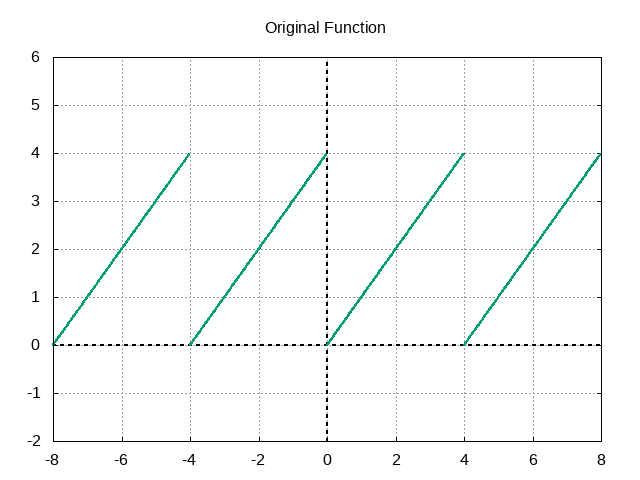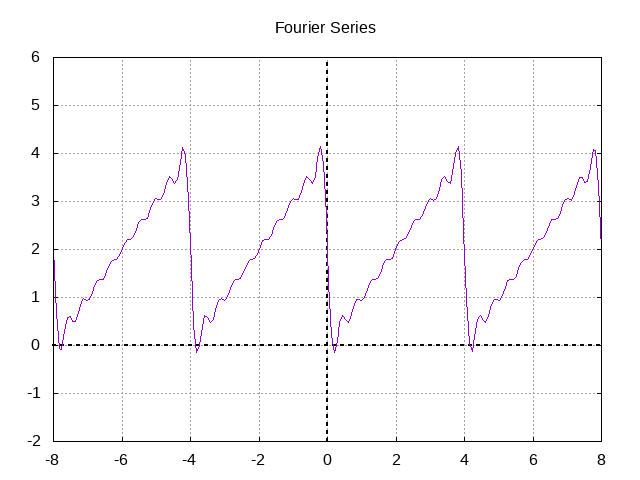Checking if gsl_integration_qng() will work
At the end of part 1, I suggested
that gsl_integration_qng() would not be able to successfully
integrate the function we want to find the Fourier series of. Here is
the function I will find the Fourier series of.

Because this function is discontinuous, we have to approximate it with
a Fourier series instead of a Taylor series. If we recall the formulas
shown in the last part, we know that we will have to integrate from to , among other things. Before calculating the
Fourier series, let's try using gsl_integration_qng() to perform
basic integration.
#include <stdio.h>
#include <math.h>
#include <gsl/gsl_integration.h>
/* f(x) = x for 0 <= x < 4, repeating */
double f(double x, void *params) {
const double period = 4;
return fmod(x, period);
}
int main() {
double result, error;
double low = 0, high = 8;
gsl_function F = {.function = &f};
double err_abs = 0, err_rel = 1;
size_t num_evals;
gsl_integration_qng(&F, low, high,
err_abs, err_rel,
&result, &error, &num_evals);
printf("result error num_evals\n");
printf("%f %f %zu\n", result, error, num_evals);
}Results:
| result | error | num_evals |
| 14.804436 | 8.015135 | 21 |Well, something happened here, but it's not quite what we wanted. We
told GSL to take gsl_integral-i. Since we're dealing with a
discontinuous function, we can rewrite this as gsl-integral-rewrite-i. Now I'm no mathematician, but this answer should be
16, not 14.8. Additionally, our error is very large, and if I attempt
to lower err_rel to a smaller value, GSL yells at me saying that
it failed to reach the requested error.
This is not a problem on GSL's end. We aren't using the right
integration function for the job! According to the GSL manual,
The QNG algorithm is a non-adaptive procedure which uses fixed Gauss-Kronrod-Patterson abscissae to sample the integrand at a maximum of 87 points. It is provided for fast integration of smooth functions.
While that's a lot of words, the important part is the last sentence. gsl_integration_qng() is for smooth functions. Our function is not smooth, it has a discontinuity! We will need to find an alternative
function in GSL that can handle discontinuous graphs.
gsl_integration_qng() and discontinuities
Fortunately we do not have to look far. The very next function
mentioned in the
manual is what we need. gsl_integration_qag() has the following signature.
int gsl_integration_qag(const gsl_function * f,
double a, double b,
double epsabs, double epsrel,
size_t limit, int key,
gsl_integration_workspace * workspace,
double * result, double * abserr)f, a, b, epsabs, epsrel, result, and abserr are all the same as gsl_integration_qng(). We can see that several
new terms are introduced however.
workspace is a pointer to an area of memory used by gsl_integration_qag. We allocate space by using the gsl_integration_workspace_alloc() function, This function is passed
an integer to adjust how much memory we want to allocate. Whatever
integer we pass to gsl_integration_workspace_alloc()we need to
ensure that limit is the same. This way, gsl_integration_qag
knows how much memory it has available.
key is a integer between 0 through 6. GSL recommends using higher values when integrating smooth
functions, and lower values when functions are discontinuous.
Let's see how well gsl_integration_qag() performs!
#include <stdio.h>
#include <math.h>
#include <gsl/gsl_integration.h>
double f(double x, void *params) {
const double period = 4;
return fmod(x, period);
}
int main() {
size_t limit = 1024;
gsl_integration_workspace *w
= gsl_integration_workspace_alloc(limit);
double result, error;
double low = 0, high = 8;
gsl_function F = {.function = &f};
double err_abs = 0, err_rel = 1e-7;
gsl_integration_qag(&F, low, high,
err_abs, err_rel,
limit, 1, w,
&result, &error);
/* get into the habit of freeing memory when done! */
gsl_integration_workspace_free(w);
printf("result error\n");
printf("%f %f\n", result, error);
}Results:
| result | error |
| 16.0 | 0.0 |Look at that! We are getting the exact value we expected, even though we're integrating with a discontinuity. We are now at the point where we can calculate the Fourier series for our function.
Generating our Fourier series
Let's recall that we can find our and coefficients with the following formulas.
GSL expects us to only pass one function to it as an argument. That
means that, unlike before, we can't just pass a pointer to our function
f(x), as GSL won't be multiplying it by the cosine and sine terms.
There are a couple of solutions to this that I can think of. The first
is to make use of the void * argument that GSL includes in the
gsl_function structure. Using this, we could pass extra information
to f(x), adapting it to our specific n value.
Alternatively, we could write a parent function, like aorb_subn(). This
function would then be stored in the gsl_function structure. The
advantage of this approach is that the function we want the Fourier
series of, f(x), is distinct in our code. This should make it a bit
easier to change f(x) to any function that we want. This is the
approach that I will take.
To make this code hopefully a bit more modular, I moved the
integration out of main, and instead into a function called
get_aorb_subn(). This function calculates the nth Fourier
coefficient for a function f(x), using the variable get_a to
determine if it should calculate or . It may be
better to wrap this in a fourier structure that contains the two
terms, but I elected not to do that to hopefully maintain some vague
semblance of readability.
This is what the code to calculate the Fourier series looks like.
#include <stdbool.h>
#include <stdio.h>
#include <math.h>
#include <gsl/gsl_integration.h>
#define PI 3.14159
const double period = 4;
const double l = period / 2;
struct aorb_params {
double (*f)(double x, void *params);
int n;
bool calc_a;
};
double f(double x, void *params) {
return fmod(x, period);
}
double aorb_subn(double x, struct aorb_params *params) {
int n = params->n;
double trig = params->calc_a ? cos(PI*n*x/l) : sin(PI*n*x/l);
return params->f(x, NULL) * trig;
}
double get_aorb_subn(double (*f)(double x, void *params), int n,
double low, double high, bool get_a) {
double normalization = 1/l;
if (get_a && n == 0) normalization /= 2;
size_t limit = 1024;
gsl_integration_workspace *w
= gsl_integration_workspace_alloc(limit);
double result, error;
gsl_function F = { .function = &aorb_subn,
.params = &(struct aorb_params){ .f = f, .n = n,
.calc_a = get_a } };
double err_abs = 0, err_rel = 1e-7;
gsl_integration_qag(&F, low, high,
err_abs, err_rel,
limit, 1, w,
&result, &error);
gsl_integration_workspace_free(w);
return normalization * result;
}
int main() {
const int upto = 10;
double a_subn[upto], b_subn[upto];
double low = 0, high = period;
for (int i = 0; i < upto; i++) {
a_subn[i] = get_aorb_subn(f, i, low, high, true);
b_subn[i] = get_aorb_subn(f, i, low, high, false);
printf("%d %f %f\n", i, a_subn[i], b_subn[i]);
}
}Results:
| n | a_subn | b_subn |
|---+--------+-----------|
| 0 | 2.0 | 0.0 |
| 1 | -7e-06 | -1.273242 |
| 2 | -7e-06 | -0.636621 |
| 3 | -7e-06 | -0.424414 |
| 4 | -7e-06 | -0.31831 |
| 5 | -7e-06 | -0.254648 |
| 6 | -7e-06 | -0.212207 |
| 7 | -7e-06 | -0.181892 |
| 8 | -7e-06 | -0.159155 |
| 9 | -7e-06 | -0.141471 |Like I mentioned before, aorb_subn is a "parent function" that
combines f(x) and the sine/cosine term. This is the function we
integrate, and we provide it enough information to know what term we
are calculating.
Interestingly, if we use the constant M_PI, the integration
fails due to roundoff error. Fortunately we can get "close enough"
values by just using a few less digits.
Once we graph the Fourier series generated by these coefficients, this is what we get.

And there we are! Here is a Fourier series generated for a discontinuous periodic function. The more terms we add, the more accurate the approximation.